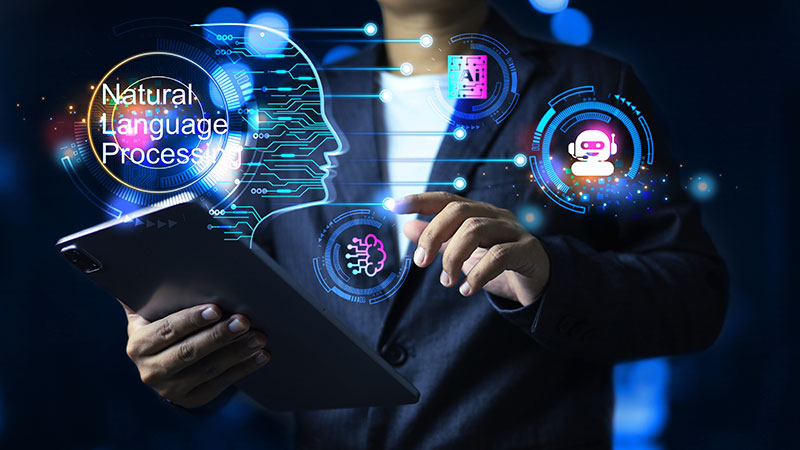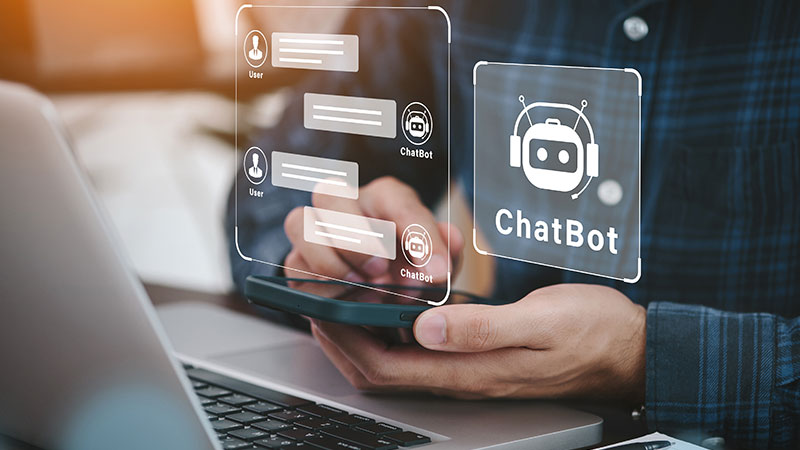Your quest for comprehensive, reliable information on AI chatbots, also known as AI assistants, ends here. With AI-powered chatbots leveraging advanced technology to deliver automated conversations, we’re about to embark on an informative journey, exploring the diverse types of AI chatbots, also known as AI chat, and offering you some key points to consider when choosing the right one for your needs. This exploration will include insights into the best AI chatbots, guiding you towards high-quality AI chatbot solutions tailored to your specific requirements.
Getting Acquainted with Conversational AI Chatbots

Let’s get started by understanding what an AI chatbot is. An AI chat, or artificial intelligence chatbot as it’s formally known, is a computer program developed to imitate human conversation. It does this through text or voice interactions, leveraging AI technologies such as natural language processing (NLP) and machine learning to comprehend and respond to user inquiries.
The way AI chatbots, or chatbot AI, function is by examining user input, deciphering the intent behind the message, and generating suitable responses. They are trained with large volumes of data to detect patterns, comprehend context, and provide precise and pertinent information to users. This conversational AI technology offers numerous advantages. Utilizing various AI models, these chatbots can adapt to a wide range of tasks, from generating business-ready copy to creating educational graphics, enhancing their versatility and effectiveness.
AI chatbots deliver 24/7 customer service, enabling businesses to provide uninterrupted assistance, thereby improving customer satisfaction and slashing response times. Secondly, AI chat, or conversational AI, can manage multiple conversations at once, allowing businesses to cater to a larger volume of inquiries without expanding their support team. Moreover, chatbots can swiftly and accurately pull information from databases or external sources, offering users immediate access to the information they need. Lastly, AI chatbots are designed to learn and improve over time, becoming more efficient and effective in comprehending and addressing user inquiries. Integrating chatbot software into these systems further enhances their capabilities, introducing new features, workflows, and integrations that significantly improve online ordering, lead generation, and cost reduction for businesses.
AI tools, encompassing AI chatbots, represent a broader category of technology equipped with a wide range of tasks and features, from conversational interfaces to complex problem-solving capabilities, showcasing the diversity and strength of AI applications in various domains.
Unveiling the Varieties of Natural Language Processing AI Chatbots

AI chatbots, or chatbot AI, are not a one-size-fits-all solution. There are various types, each serving a distinct purpose. Let’s delve into three common types of AI chatbots: generative AI chatbots, conversational AI agents, and AI agents for contact centers.
Generative AI chatbots: These chatbots, or AI chat, are engineered to generate responses based on a set of rules or patterns. They harness natural language processing and machine learning algorithms to understand user queries and provide relevant solutions. Generative AI chatbots excel at handling simple inquiries and supplying basic information.
Conversational AI agents: Conversational AI agents are sophisticated chatbots capable of engaging in human-like dialogues. They employ machine learning algorithms and deep learning techniques to understand context, sentiment, and even emotions. Conversational AI agents aim to provide a more personalized and interactive user experience, elevating the AI chat experience. An example of such an agent is Bing AI, a conversational AI chatbot powered by OpenAI's GPT and DALL·E models. Integrated with Microsoft Edge, Bing AI offers features like online search, text, and image generation, and provides source citations, though it may sometimes give shallow answers.
Building your own chatbot, such as with Zapier's free Chatbots, allows for the creation of custom AI-powered chatbots. This process involves customizing features, training the chatbot on specific documents, and starting with pre-made templates, enabling users to tailor their own chatbot to meet specific needs.
AI Agents for Contact Centers: A Deep Dive into Chatbot AI
AI agents for contact centers are a specialized type of chatbot AI designed to optimize contact center operations. These AI chatbots are equipped to handle a wide range of customer queries, from basic FAQs to more complex issues. They efficiently manage initial customer interactions by providing immediate responses, which can significantly enhance customer experience and reduce wait times. When a query requires human intervention, these AI chatbots can seamlessly escalate the matter to human agents, ensuring that customers receive the necessary level of support.
In addition to basic query handling, AI agents for contact centers are programmed to offer support by accessing customer data, providing personalized assistance based on customer history and preferences. This capability allows for a more tailored customer service experience, where responses are not only fast but also contextually relevant.
The implementation of AI chatbots in contact centers leads to a streamlined workflow, where repetitive and time-consuming tasks are automated. This automation allows human agents to focus on more complex and sensitive issues, thereby optimizing the workforce and reducing operational costs. Overall, AI agents for contact centers significantly boost customer satisfaction by ensuring that all inquiries are handled efficiently and effectively, whether by the AI chatbot or a human agent.
NICE's Tailored AI Chatbot Solutions
At NICE, we are dedicated to delivering a diverse range of AI chatbot solutions, each developed with cutting-edge technology to meet specific business needs. Our portfolio includes everything from generative AI chatbots, which are superb for handling straightforward tasks and queries, to more sophisticated conversational AI agents that can engage in dynamic and complex dialogues with users.
For contact centers, our AI agents are designed to not only respond to inquiries but also to analyze customer feedback and behavior, enabling continuous improvement in service delivery. This focus on adaptability and learning is what sets our AI chatbots apart, as they evolve to meet changing customer expectations and business requirements.
One standout feature available in some of our AI chatbot solutions is the ‘genius mode’. This advanced capability enhances the chatbot's decision-making processes, allowing it to handle unexpected queries more intelligently and provide solutions that go beyond pre-defined scripts. Additionally, premium plans might include innovative features like image generation credits, which can be used to visually enhance customer interactions and provide more engaging content.
Enhancing Operational Efficiency with AI Chatbots
Choosing an AI chatbot from NICE means selecting a solution that is tailored to enhance your customer service operations and improve overall efficiency. Our AI chatbots are designed not only to meet immediate customer service needs but also to integrate smoothly with existing business systems and workflows, providing a seamless experience for both customers and service agents.
Whether you are looking to enhance customer interaction, streamline operations, or reduce the burden on your human workforce, our AI chatbot solutions are here to help. By leveraging the power of AI, we help you transform your contact center operations and achieve a higher level of customer satisfaction and operational excellence.
Selecting the Best AI Chatbots: Key Factors

When selecting an AI chatbot for your business, diving deeper into the key factors and considerations can help you make a more informed decision. Here’s an expanded analysis of each key aspect to consider:
1. Cost and Budget Compatibility:
-
Understanding Pricing Models: AI chatbots may come with different pricing strategies such as tiered, usage-based, or flat-rate models. It's important to understand the implications of each model. For instance, tiered pricing can scale with the size of your business while usage-based models are dependent on the volume of interactions.
-
Forecasting Long-Term Costs: Consider the long-term implications of your choice. This includes not only the upfront costs but also long-term expenses like upgrades, support, and potential scaling needs. Evaluating the total cost over a projected period, such as five years, can provide a clearer picture of the financial commitment involved.
2. Purpose and Functionality:
-
Role-Specific Features: Depending on whether you need the chatbot for customer support, sales, or another function, the required features can vary significantly. For instance, a customer support bot needs strong natural language understanding capabilities to interpret and respond to customer queries effectively.
-
Adaptability and Learning: Evaluate how well the chatbot can learn from interactions and adapt to changing user behaviors or expectations. The ability to update its knowledge base and improve over time is crucial for maintaining effectiveness.
3. Integration Capabilities:
-
Seamless Integration: The ease with which the chatbot integrates into your existing systems (like CRM software, databases, and other APIs) is crucial. Poor integration can lead to silos and inefficiencies, whereas a well-integrated system enhances productivity and user satisfaction.
-
Extensibility: Check if the chatbot platform allows for adding new functionalities or integrating with new systems as your business grows and technology evolves.
4. Web Search Functionality:
-
Control and Customization: The ability to customize the depth and breadth of the web search capabilities of your chatbot is important. This includes setting parameters for what types of information are retrievable and managing how this information is presented to users.
-
Privacy and Security Concerns: If the chatbot can access and relay information from the web, ensuring that this feature complies with your company’s security and privacy policies is paramount. You might need to restrict access to certain types of data or websites to maintain compliance and safeguard user data.
5. User Experience and Interface:
-
Personalization Capabilities: A chatbot that can offer personalized interactions based on user history or preferences can significantly enhance the user experience. Personalization can range from simple name recognition to complex predictive behaviors based on user interaction history.
-
Multilingual Support: If your business serves a diverse demographic, consider a chatbot that supports multiple languages to widen your reach and improve engagement.
6. Security and Compliance:
-
Regular Updates and Maintenance: Ensure that the chatbot platform receives regular updates that address new security vulnerabilities and that it complies with any new regulations.
-
Audit Trails and Reporting: For compliance and monitoring purposes, it may be essential for the chatbot to maintain logs of interactions and decisions. This helps in reviewing its performance and auditing its actions for compliance with policies and regulations.
By thoroughly evaluating these factors, businesses can select an AI chatbot that not only meets their current requirements but is also robust enough to adapt to future challenges and opportunities. This strategic approach to selection helps maximize the return on investment and ensures the chatbot effectively contributes to achieving business objectives.







